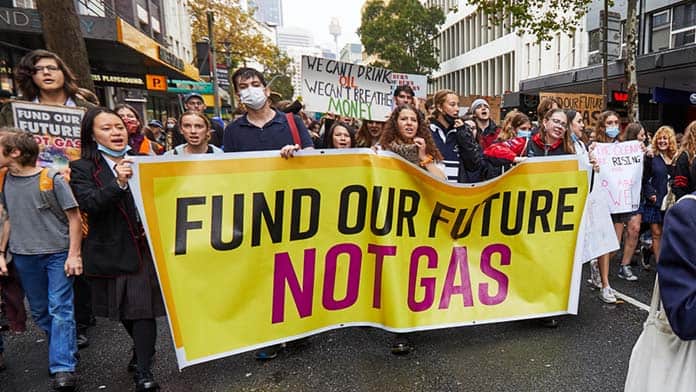US President Joe Biden’s virtual summit exposed Scott Morrison’s failure to adopt any serious climate policy. Morrison is trying to distract from this by promising investment in low carbon technologies like hydrogen—but a closer look shows his plans are just another effort to continue support for fossil fuels.
The Federal Budget was silent on climate jobs, environmental protection, or climate action. Instead of funding and investing in renewable energy technology, environmental restoration, public transport, climate jobs, or a national just transition body (to name a few), the Morrison government has decided to throw more public money at carbon intensive industries.
The government increased public funding for fossil fuels by committing another $58.6 million to “advancing Australia’s gas-fired recovery” and allocated nearly $1.2 billion to develop hydrogen and carbon capture and storage (CCS). It also wants to change the Australian Renewable Energy Agency’s rules to allow it to fund them.
Morrison claims that hydrogen and CCS are technologies needed to cut emissions, yet the government refuses to support zero emissions technologies such as solar, wind and hydro power that are already available.
Green hydrogen, produced using electricity from renewable energy, could play a role in zero emissions manufacturing and freight transport.
But there is a marked difference between “blue” hydrogen, which is made from methane, gas, or coal and creates carbon emissions, and “green” hydrogen, which is made from renewables and releases only oxygen, and is therefore climate friendly.
The Morrison government’s five hydrogen production hubs will be located near coal and gas reserves, indicating that it aims to produce “blue” hydrogen, and is simply another effort to extend the life of fossil fuels.
Gas expansion
The government has also provided $30 million for a gas power plant at Port Kembla, on top of a $5 million contribution to another nearby gas plant Tallawarra B in Wollongong that has received $78 million in NSW government funding.
And it has now announced up to $600 million to build a gas power station at Kurri Kurri near Newcastle entirely with taxpayers’ money. An Environment Impact Statement revealed it was likely to run on more polluting diesel fuel for its first six months of operation, until gas pipelines are completed.
Other new measures include $38.7 million for targeted gas infrastructure projects at Golden Beach and Iona (in Gippsland, Victoria), the expansion of a South West Victorian Pipeline, and an import gas terminal at Port Kembla (in Wollongong, NSW).
These projects expand the Morrison government’s plans for a “gas-fired recovery” from the COVID crisis, including unlocking five gas basins, notably the Beetaloo Basin in the Northern Territory and the Galilee Basin in Queensland, and shoring up other pipelines and “critical” infrastructure.
It justifies its commitment to gas as necessary to provide cheap and reliable electricity as well as jobs. This rests on claiming renewable energy can never be reliable enough to meet all our energy needs. This is untrue, as batteries are capable of providing the capacity to store renewable generated power.
The Morrison government has intentionally missed a pivotal moment to prioritise climate action. The increase in government spending brought on by the COVID-19 pandemic provided a chance to move towards climate jobs as part of acting on climate change.
While other governments, such as the Biden administration in the United States, are talking of increasing their targets for cutting emissions to around 50 per cent by 2030, the Morrison Government remains deeply committed to its current climate and energy policy—more gas, and a refusal to change Australia’s existing pledge to cut emissions by 26-28 per cent below 2005 levels by 2030.
Australia is a global leader in fossil fuel trade and extraction, and wants the world to continue its dependence on fossil fuels. As recently as last year, Australia became the world’s largest exporter of LNG (liquified gas). An Australian Conservation Foundation report found that “when we add Australia’s exported emissions to our domestic emissions, Australia rockets equal fifth on the list of major global climate polluters, alongside Russia, behind India, the EU, China, and the US”.
Morrison’s support for gas development is designed to promote fossil fuels as a source of jobs. Labor is still not willing to challenge this.
The climate movement needs to begin mobilising again in serious numbers. The high school-led Climate Strike on 21 May will be our first major opportunity. Its call to “fund our future not gas” also dovetails with Aboriginal resistance movements like the Gamilaraay Next Generation, who are fighting the proposed $3.6 billion Narrabri coal seam gas field in NSW. Building union support and a fight to fund climate jobs will also be key to challenging the Morrison government’s destructive fossil fuel obsession.
By Dylan Goldsworthy






